/cdn.vox-cdn.com/photo_images/2182002/GYI0063949063.jpg)
In recent matches, Manchester United boss Sir Alex Ferugson has deviated from his usual tactics of either a '4-4-2' or a hybrid '4-3-3/4-5-1' and instead gone with a '4-2-3-1' shape. In these five matches with the new formation, United have won four of them, including wins over Arsenal FC and Olympique de Marseille. Wayne Rooney has thrived in a playmaking role with three goals and two assists in this five game span while Javier 'Chicharito' Hernandez has continued his superb form by bagging four goals.
INTRODUCTION TO '4-2-3-1'
It could be said that the '4-2-3-1' evolved from the '4-4-2'. Typically, football position nomenclature generally breaks players down as either goalkeepers, defenders, midfielders, or forwards. In the three-banded formation of '4-4-2', the first band of four describes the number of defenders, the second band describes the midfield, and the third band describes the forwards. Where the evolution might have occurred is when one of the forwards began to drop into a deeper position in between the bands of defense and midfield. Thus, there was essentially four bands to describe a team's shape. Either a '4-4-1-1' or a '4-2-3-1' resulted, depending on high up the pitch the wide-attacking players positioned themselves. If a team desired, they could still have the wide play of a '4-4-2', however, they were also able to use an attacking player as a play-maker, similar to the role of a central play-maker in a more narrow '4-4-2 diamond' or a narrow '4-3-1-2'.
The first diagram shows a general '4-4-2' shape in Black and a '4-2-3-1' in Red. The playmaker is boxed in yellow.
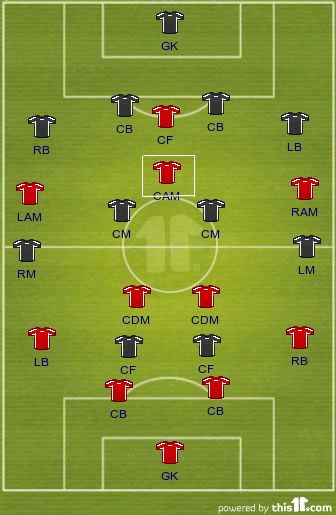
The second diagram shows a '4-4-2' diamond in Blue. Recent examples are Carlo Ancelotti's AC Milan sides and his double-winning Chelsea FC side from last season. A '4-3-1-2' is shown in Yellow. Massimiliano Allegri's current Milan side is a team that deploys this shape. Notice how narrow each formation is. Again, the 'play-maker' is boxed in yellow.
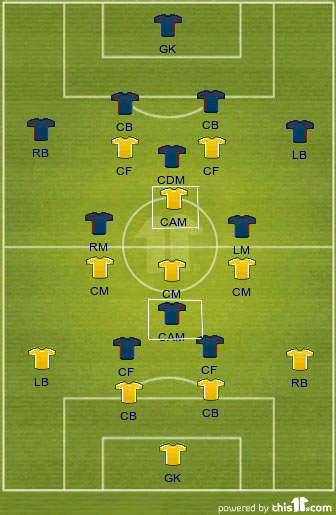
The '4-2-3-1' became prominent in Spain in the 1990s and early 2000s. Throughout the past decade, it became more widely used throughout the European continent, however, its existence in England came along slowly. Most English sides still used the classic '4-4-2', however, some clubs that adjusted their tactics to stagger their bands experienced success (Chelsea '4-1-2-3', Arsenal '4-2-3-1', United '4-1-2-3' at times, Liverpool '4-2-3-1'). The shape was also successful at this past summer's FIFA World Cup in South Africa and the sides that used it included three semi-finalists: Spain, Netherlands, and Germany.
The heart of the '4-2-3-1' shape is in it's midfield. The two distinguishing features are the 'center-attacking-midfielder' (CAM) who is withdrawn from the striker and the two holding-midfielders who are positioned in front their center-backs. Typically and very generally, the band of two holding-midfielders, also known as double-pivots, have more defensive responsibility while the band of three attacking-midfielders are more attack minded. One way to distinguish a '4-4-1-1' from a '4-2-3-1' is that the wingers are positioned higher up the pitch in the latter shape.
The CAM typically should have a skill-set that includes vision and a wide range of passing ability. Recent examples include: Wesley Sneijder (Inter last season, Netherlands), Mesut Ozil (Real Madrid, Germany), Cesc Fabregas (Arsenal), and Xavi (Spain). The double-pivots are asked to be able to support the defense and to dictate tempo with their passing from a deep position. Sometimes both stay deep and focus on defensive duties (Netherlands: Martin Van Bommel and Nigel De Jong); sometimes responsibilities are delegated to have one player focus on shielding the defense while the other initiates the attack from a deep position (Liverpool under Rafa Benitez: Javier Macherano defensive and Xabi Alonso passer); or sometimes both can perform a hybrid role, similar to the classic 'box-to-box' role (Arsenal: Alex Song and Jack Wilshere).
There are three strengths in this shape that I personally like:
* (1) The bands of four, as opposed to three, allow you to stagger your shape vertically. The CAM puts an opponent into a conundrum as either a center-back or center-midfielder is likely to get dragged out of position when the CAM drifts in between the opponent's defense and midfield. The same concept allows you not to be exposed in the same space in between the bands when you are out of possession.
* (2) If the CAM drops deep enough, the '4-2-3-1' can prevent you from being outnumbered in the center of the pitch versus sides that field three central midfielders, thus you can prevent from being overrun. You can flood the middle of the pitch if necessary, however, you still have the option to have width with your wingers.
* (3) It can be either rigid or flexible. If you want to stabilize your side when you are out of possession, the deep-lying double pivots allow you to have six defenders if you prefer your shape to be rigid in defense. If your four attackers are creative and talented enough, this can be effective (e.g Netherlands). If you want fluidity, you can have your attackers interchange positions and have your double-pivots join the attack with late-arriving runs. If you want flexibility, you can play in an asymmetrical shape, similar to what Brazil arguably did last summer in the World Cup.
MANCHESTER UNITED'S APPLICATION OF '4-2-3-1'
As previously mentioned, United have used the '4-2-3-1' shape to start five of their past six matches. Although the sample size is small in determining whether or not this shape is ideal or even a positive tactically for United, the recent results have shown success versus sides in various competitions and various formations. The victories include Barclays Premier League play versus Wigan Athletic (who countered with a '4-3-3') and Bolton Wanderers ('4-4-2'), a Champions League clash with Marseille ('4-1-4-1'), and a FA Cup tie with Arsenal ('4-2-3-1'). Even the loss at Stamford Bridge versus Chelsea ('4-4-2') included a 1st half by United that was arguably their best all season away from Old Trafford.
Chicharito:
It's interesting to note that in all five matches where Sir Alex has elected to begin in a '4-2-3-1' shape, the Gaffer has decided to call on Chicharito as his striker over the Premier League's leading goal-scorer Dimitar Berbatov. The Bulgarian's only recent start came at Anfield versus Liverpool FC when United played in '4-4-2' shape in the first half and in a '4-3-3' in the 2nd half. With a lone striker in the '4-2-3-1' formation, some managers prefer to have a strong target-man who can hold the ball up and link play while other's prefer their striker to have excellent pace and movement so that they can stretch a defense. It appears that Fergie prefers the latter. Chicharito's movement off the ball has been excellent as he continually has moved wide to receive and drag center-backs into wide areas. Also, from these wide areas, he's been exceptional at timing his runs and making diagonal sprints into the box where he's creating consistent goal-scoring chances. Furthermore, his work-rate has been fantastic as well as he's worked hard to pressure and press opposing defenders, including into the corners when United have been out of possession. For tangible evidence of his success, four goals and an assist in five matches can attest to it.
Rooney:
Simply put, Wazza has been superb in his role as the CAM. When United are in possession, he typically starts from a high position that is withdrawn from Chicharito and then comes deep to receive the ball. When he makes this movement into the space between the opposition's defensive and midfield bands, he often drags a center-back out of position when one decides to follow Rooney. If the center-back passes him off, then its generally a center-midfielder who drops too deep and is dragged out position, thus leaving space for another attacker to exploit.
This diagram shows a hypothetical example. If a center-back (CB) follows Rooney into the mentioned space (yellow box), the CB leaves exploitable space for either Valencia or Giggs to expose with a run into that area. If one of the center-midfielders (CM) drops deep to pick up Rooney, then either Carrick, Gibson, or someone else will have space and time on the ball.
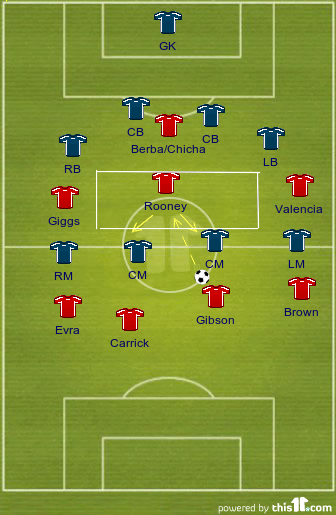
The touch, vision, and range of passing that Wazza has displayed recently has been an absolute treat to watch. This doesn't even touch on his work-rate and movement that has allowed him to continually out-wit and slip his marker. His contribution on United's first goal in their recent match versus Marseille is a microcosm of his play as of late as a CAM: Wazza received the ball, played a sublime pass with the outside of his right foot to Giggs on the left flank, then he sprinted 30 yards up the pitch to receive back from Giggs, and then split two defenders with a pass across goal that found Chicharito for the tap in.
Rooney has also done well to link with Chicharito and provide the young Mexican striker with quality service. Here are Fergie's comments on their partnership after the Marseille match:
"It's developing well. Where Wayne has played in the last couple of games, he is a real threat because he has such power and speed with the ball. And, of course, Hernandez is unbelievable with his movement. If you see his movement for the first goal, he made three different types of runs. The boy's got goals in him"
Rooney has provided for the wide players as well as this Guardian chalkboard from the Bolton match displays:
Double Pivots:
If you have the right personnel, the '4-2-3-1' shape can allow you to dictate possession. In the five matches in this shape, the only game where United lost the possession battle was versus Arsenal. However, United started seven defenders in that match due to injury, including John O'Shea in the midfield as a holding player. In the other games, the double-pivot pairing has mostly been Paul Scholes and Michael Carrick. Despite playing in such a deep role, neither are known for their defensive abilities, especially Scholes. Both in this deep position can better be described as deep-lying play-makers. They are terrific passers and their technical ability has allowed them to boss matches in the center of the pitch by dictating tempo from a deep position. Both have done well to swing the ball wide to the wingers and Scholes in particular has done well to spray long diagonal balls to the flanks for Ryan Giggs, Nani, and Antonio Valencia to run onto. Generally in this area of the pitch, there simply aren't enough natural foils for Scholes and Carrick in this deep position, so if one is pressed, the other simply offers and receives if he is open. If two opposing center-midfielders close down on both Scholes and Carrick, then Rooney likely has acres of space to come deep into; this allows Wazza plenty of time to receive, turn, and find either a wide player or Chicharito. This continually occurred versus Marseille as this diagram exhibits:
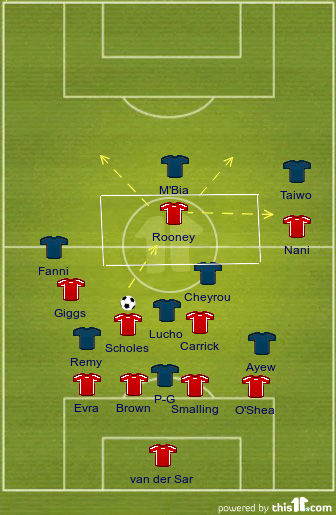
The main drawback to this pairing is that they appear somewhat vulnerable to fatigue, especially the 36-year-old Scholes. Since neither Carrick or Scholes are being paired with a defensive-minded player, one with the tenacity and grit to do some of the grunt-work here, it's possible they are fatiguing late in matches. When Darren Fletcher returns to health, it'll be interesting to see how he does in this role. A Scholes-Fletcher pairing is an intriguing possibility if Fletcher is able to take care of most the defensive responsibilities and free up Scholes to focus on distribution.
Wide Players:
There isn't much difference in the roles of the wide players in this formation from their usual ones. However, one interesting thing to note is the asymmetrical shape United have played in when Darren Fletcher has been the wide player on the right. In these occurrences versus Wigan and Chelsea, Fletcher has played somewhat deep and centrally. When United were in possession, Fletcher provided width by staying near the touchline. When United were out of possession, he floated inward and almost provided another center-midfielder in defense. On the opposite side, Nani stayed high up the pitch, a position that typically had him playing higher in attack than Rooney. When Giggs, Valencia, and Nani have been tasked out wide in some sort of combination of two, the shape has been much more symmetrical. Here's a tactical diagram from the Wigan match that displays Fletcher's positioning:
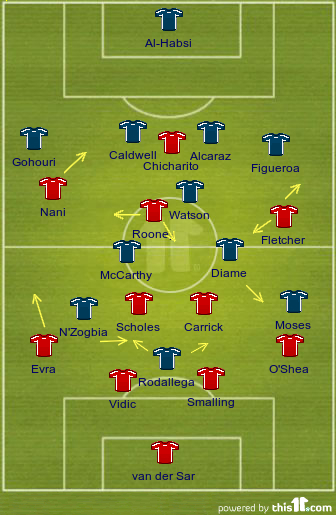
Conclusion:
Predicting the future tactics of Sir Alex is difficult, so who knows what the United boss will unveil when his squad begins returning to health. If I had to guess, I'd say Fergie continues with the '4-2-3-1' shape in early April after the international break versus Chelsea in the Champions League quarter-final. This is my guess because the tactics have been successful thus far in their brief use and they appear to maximize the strength of United's current personnel; specifically their talisman Rooney.
